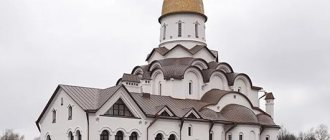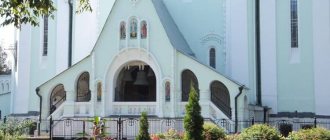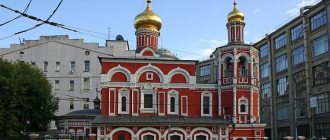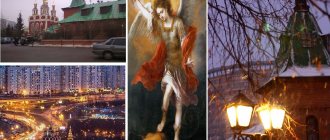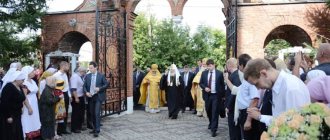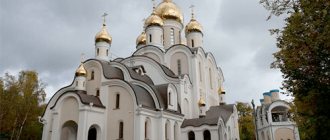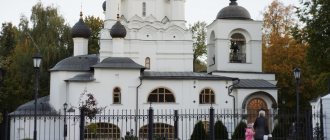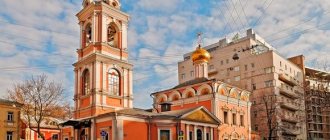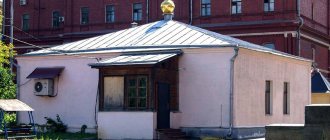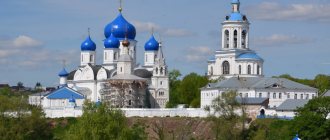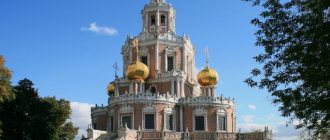The Yekaterinburg Church on the Blood in the name of All Saints who shone forth in the Russian land is one of the main attractions of the city. The Voznesenskaya Gorka area has become notorious throughout the world. It was here that until 1977 the house of engineer Nikolai Nikolaevich Ipatiev stood, in which the last Russian Emperor Nicholas II with his family and servants were shot.
© Elena
Because of this event, which occurred on the night of July 16-17, 1918, the temple received its name. The Church on the Blood is visited not only by religious parishioners, but also by tourist groups. Most often, it is included as part of a city sightseeing tour. He considers it one of the most popular temples in the country. The Ekaterinburg Temple became the third “Church-on-the-Blood” after Uglich and St. Petersburg.
© Anna Kudryavtseva
The architectural complex includes the five-domed main church, the Elizabeth Chapel and the Patriarchal Compound. Together with several other temples, it forms the “Holy Quarter”. It includes the Ascension Church and the Church of St. Nicholas the Wonderworker.
What's the best way to get there?
There are quite a few transport options - they will take you to the temple both underground and on the ground:
- take the metro line to the Dynamo station and cross the park area;
- take the bus to the Philharmonic or Youth Theater stop (No. 1, 13, 15, 20, 23, 31, 48, 57);
- the tram will take you to the stop “Theatre of Musical Comedy”, from where it is about 500 m to the temple (No. 2, 6, 13, 15, 18, 26, 27);
- Trolleybuses also go to the “TYUZ” stop (No. 1, 3, 4, 5, 9, 11, 15, 17, 19);
- minibuses go both to the Youth Theater stop and to the Philharmonic (056, 052, 035 and 021).
Where can you stay nearby?
Unfortunately, neither in the cathedral itself nor nearby are there any pilgrimage hotels ready to host traveling believers. However, there are quite a few hotels near the temple, which differ in both pricing and comfort.
- The courtyards of the Chapel are 300 m from the temple. Estimated cost of an economical double room is 2,300 rubles;
- Hotel complex “Nauka” is 0.5 km from the church. The lowest price is offered for a double room - 1,519 rubles;
- Cannon INN - 300-350 m from the cathedral. The approximate price for an economical double room will be about 5,720 rubles;
- Hotel Ekaterina is 400 m from the temple. A comfortable double room is offered, the price of which is 5,900 rubles;
- Grand Hotel Europe – 0.5 km from the cathedral. The cost of a luxury room will be 22,360 rubles.
Visit. Working hours
- The place of worship is open almost 24 hours a day.
- You can get there from 7:30 every day. What is unusual for a functioning temple is the late closure.
- The schedule on the website of the Church on the Blood of Yekaterinburg shows evening opening hours - until 23:00.
- You can come specifically for a tour and pay with a donation. Thanks to the guide, you will understand the symbolism of the temple and see where it is emphasized in the interior. Don't forget to climb the belfry to the bells.
Don't worry about women's indecent clothing: there are appropriate skirts and scarves at the entrance.
Current state[edit]
At the moment, the Church on the Blood is not only a functioning cathedral, but also a museum complex. The museum part displays a number of exhibits dedicated to the last months of the life of Emperor Nicholas II and his family. The church operates a Sunday parochial school for children aged 6 years and older, and also conducts Bible courses for everyone.
The wooden chapel in the name of the Venerable Martyr Elizabeth survived, despite a number of arson and acts of vandalism, and is now located between the built buildings of the temple and the Patriarchal Metochion. The frame of the chapel became dark in color due to arson. In front of the chapel on the ground lies a large marble stone with an inscription stating that on the night of July 17, 1918, members of the Romanov royal dynasty were killed here.
The Patriarchal Metochion, built and consecrated together with the temple, includes the patriarchal chambers itself, the house church of St. Nicholas, a library, as well as a number of halls and premises for holding various high-level church events.
Every year on the night of July 16-17, from 23:30 to 04:00, the church holds a multi-hour all-night vigil and liturgy in memory of the Royal Family, which ends with a traditional 25-kilometer religious procession to Ganina Yama. In 2007, more than 20 thousand believers from all over Russia took part in the ceremonial events. And in 2008, in connection with the 90th anniversary of the murder of the Royal Family, about 40 thousand people took part in the procession. In 2011, 50 thousand people walked this path. The territory on which the Church on the Blood, the Elizabeth Chapel, the Patriarchal Compound, as well as the Ascension Church are located, according to the order of the head of Yekaterinburg A. M. Chernetsky, received the name “Holy Quarter”.
There is a Sunday school at the temple.
History of the Church on the Blood in Yekaterinburg
The temple is quite young; people started thinking about its construction even before the 2000s. And the reason was the desire to remember what happened here in 1918 . Previously, this was the same house of engineer Ipatiev , where Emperor Nicholas II, his wife Alexandra Fedorovna and 5 children - Olga, Tatyana, Maria, Anastasia and Alexei Romanov - spent 78 days in captivity before his death. The ill-fated house stood until 1977 . Then people flocked to the place of death, which prompted them to think about building a memorial temple. From the laying of the first stone (1992) to the finishing work, 11 years passed. Things moved forward only after the canonization of the Romanovs. The construction itself, designed by three architects, lasted 3 years, from 2000 to 2003.
Architectural and cultural landmarks
- The Church-Monument on the Blood in Yekaterinburg consists of two levels: below, in the lower temple there is a museum of the Romanov family and a room called the “execution room” (real stones and bricks of Ipatiev’s house were used in its arrangement). Both temples, upper and lower, differ even in color. The lower one represents the basement where 11 people were killed by the Bolsheviks, which is why it is decorated in burgundy color, the color of blood. But in the upper, bright church you can see a large marble iconostasis (made of rare stone, by the way). To say “big” is not enough, you need to see it: its dimensions are 30 by 13 meters!
- Monument to the royal family by K. Grunberg. The moment of descent into the basement to the death of all the Romanovs seemed frozen in stone: 7 cowering figures at the cross and 23 steps down.
- Concert hall for 160 people with a grand piano that once belonged to the emperor's family.
Shrines
Not only the room where the royal family was shot is considered a relic of the temple, but also decorated iconostases and gifts from fellow believers . There are no relics that are constantly in the Church on the Blood in Yekaterinburg in the public domain; they are brought in connection with special holidays (for example, the relics of Seraphim of Sarov). But at the base of the temple the relics of Simeon of Verkhoturye are kept - they consecrated the first stone of the foundation of the future temple. Among the shrines:
- The most important icon in the Church on the Blood in Yekaterinburg is the “Three-Handed” (an image of the Mother of God with stirrup hands). It cannot be said that it is notable for some miracles; rather, its history speaks for it. It belonged to the family of the murdered monarch; before it, they were executed in the Ipatiev House. Taken abroad and given to the sister of Nicholas II, the hereditary icon traveled around the world until in 2003 it returned to a memorable place as a gift from the descendants of the Romanovs.
- Icon “The Sign” in silver design. Depicts the Mother of God, received as a gift from the Ambassador of the French Republic.
- Image of the “Holy Trinity”. The gift to the church of Metropolitan Kirill for the anniversary of the diocese glitters in silver.
- Icon of the Royal Martyrs. After the death of the Romanovs, they were ranked as saints, which is why they are often depicted on icons of Russian churches. This icon came specially from the Greek Mount Athos.
- The “Burning Bush” icon has an unusual design for such icons - it depicts the Mother of God near a burning bush and there are no emphasized geometric lines.
A number of images in the temple support the theme of martyrdom. Near the altar in the temple, 10 icons can trace the history of the government of Russia: they depict rulers, starting with Prince Vladimir and ending with Emperor Nicholas.
History of creation
The construction of a church building here was never planned. But life made its own adjustments.
Biography of Emperor Alexander II
The future tsar was born on April 29, 1818, in Moscow, shortly before Easter. Alexander ascended the throne in 1855. The new tsar carried out a number of reforms, the main of which was the abolition of serfdom (1861). In addition, the following have changed towards liberalization:
- judicial system;
- local government;
- army.
However, the “public”, the various intelligentsia, demanded the abolition of the monarchy and the introduction of a constitution. Seeing that the authorities would not make concessions, the newly created organization “People's Will” decided to physically destroy the tsar.
How the Tsar Liberator was killed
Eight attempts were made on Alexander's life. In seven of them he was not even wounded.
The eighth happened on March 1, 1881. Student Rysakov threw a bomb at the carriage, but the sovereign again remained unharmed. Moreover, he personally approached the bomb thrower, who was captured by the police. Then the second homemade projectile flew right under his feet, thrown by student Grinevitsky.
Alexander died in the Winter Palace an hour after the attack. This happened on the Week of the Triumph of Orthodoxy of Great Lent. By the providence of God the day before, the emperor managed to partake of the Holy Mysteries.
Temporary chapel
Immediately after the death of the Tsar, the Duma of St. Petersburg asked the new Emperor, Alexander III, to allow the construction of a chapel on the site of his father's death. The emperor immediately indicated that he would like to see a full-fledged temple, however, he agreed to the construction.
Its design began immediately: the work was undertaken by the St. Petersburg architect Leonty Benois, the payment for construction, and the maintenance of the future clergy were paid for by the merchants Gromov and Militin . The chapel was consecrated after a little more than a month and a half. It was located on the embankment until 1883...
This building has not survived to this day: after the construction of the cathedral was completed, it was moved to another place, and later dismantled.
Architectural competition
Already on December 31, 1881, 26 projects were submitted to him. But all of them did not suit Alexander III, who wanted to see a Russian-style church repeating the architectural traditions of the 17th century. A new competition followed in May of the following year.
Drawing of the future temple (project) before the design was finalized by the architect Parland, 1883
The winner was the joint project of A. Parland and the rector of the Trinity-Sergius Hermitage in St. Petersburg, Archimandrite Ignatius (Malyshev) , who received an art education as a layman. He himself said that the image of this building was revealed to him in a dream, after which he offered A. Parland a sketch of the building.
Father Ignatius also proposed dedicating the cathedral to the Resurrection, so that the memorial would testify not to sorrow, but to the Lord’s victory over death.
Construction of the temple
Although the foundation stone for the future cathedral was laid on November 6, 1883, the actual construction of the walls began only in 1887. The reason for the delay was changes in the design.
Alexander III certainly wanted to keep the place where his father was killed inviolable, right down to part of the fence and pavement, and to build a canopy over it.
To implement this idea, it was necessary to move the building towards the water by 8.5 m; after all, Alexander was killed one and a half meters from the shore.
Who built it (architect)
The construction of “Spas” was supervised by a commission headed by Grand Duke Vladimir Alexandrovich. These are 5 famous St. Petersburg architects, including D. Grimm, I. Shtrom , and others. The authors of the project also took an active part.
How many years did it take to build
In total, construction took 24 years.
Year of construction
The great consecration of the church took place on August 19, 1907. It was performed by Metropolitan Anthony (Vadkovsky) of St. Petersburg.
Photo of the Church on the Blood in Yekaterinburg
Church of the Savior on Spilled Blood Yekaterinburg from a bird's eye view
Yekaterinburg took a long time to build the Church of the Savior on Spilled Blood, and this is no coincidence. Its construction is a people's initiative.
The lower part of the walls of the cathedral is decorated with reddish granite and marble, symbolizing the blood shed here.
On the right are memorial plaques with the names of all members of the royal family. And the main shrine is the altar, erected at the site of the death of the royal family.
Temple building
The historical center of St. Petersburg is a mixture of different architectural styles, such as Art Nouveau, Classicism and Empire. And in the center of the splendor of classical forms and styles is the amazing Church of the Savior on Spilled Blood. The building, built by the best architects, is decorated with bright domes, kokoshniks, interesting brickwork and pilasters.
Architecture
The temple is a striking example of the last stage of the so-called Russian style. The structure combines several images of Russian Orthodox cathedrals. When designing the building, architect Alfred Parland was guided and inspired by the churches of Moscow and Yaroslavl, which were built in the 16th-17th centuries.
Every visitor and resident of the city, at the first glance at the temple, notices a striking resemblance to St. Basil's Cathedral, which is located on Red Square in Moscow.
The appearance of the temple is painting in every sense of the word. The Savior on Spilled Blood is skillfully decorated and full of all kinds of details in bright colors. The temple is richly decorated with tiles, ornaments and icons. Various finishing materials were used to decorate the temple:
- brick and mosaic;
- marble and gilded copper;
- granite and enamel.
The outer side of the Savior on Spilled Blood is decorated with inscriptions that tell about the grandiose victories of the country during the reign of Alexander II the Liberator.
Artful and rich decoration of the temple
The temple building is asymmetrical and elongated in the east-west direction. In the eastern part there are three altar apses:
- One is in the center.
- Two small ones on the sides. They have beautiful gilded domes.
Three altar apses with gilded domes.
In the western area of the building there is a two-tier bell tower, which is decorated with large and rich domes. The temple doors are located on both sides of the temple. One is located in the northwest corner of the building, and the second door is in the southwest wing.
Niches on the outside of the cathedral with granite memorial plaques
The temple has many niches, which are decorated with twenty memorial plaques cut from dark red granite. On these boards, all the affairs and reforms of Tsar Alexander II, from 1855 to 1881, are engraved in gilded letters. Three sides of the bell tower are decorated with the coats of arms of Russian cities, districts and provinces. All of them are lined with amazing mosaics and are the main historical and cultural symbol of the temple.
One of the sides of the bell tower, decorated with the coats of arms of Russian cities and provinces
The space between the porches is decorated with a crucifix, which was also made using the mosaic technique. At the top is a double-headed eagle - the coat of arms of the Russian state.
The entire area occupied by mosaic compositions is about 400 square meters. m.
Domes
The Church of the Savior on Spilled Blood is crowned by nine domes, which together form an asymmetrical picturesque ensemble. Some domes, for example, the main and central domes of the tent, are covered with jewelry enamel. Others are covered with gilding.
View of the temple from above, all nine domes are clearly visible here
The compositional center of the temple is a quadruple topped with a five-domed dome. It has a unique feature - instead of a head, there is a tent in the center, the height of which reaches 81 m. The tent is octagonal and has eight elongated windows in its pedestal. The structures are decorated with platbands made in the form of kokoshniks. This not only adds a “zest”, but also gives a special atmosphere.
The highest dome is a tent covered with enamel in yellow, green and white shades
At the top the tent gradually narrows. There are eight small cornices with small windows. The decoration of the tent is completed by a lantern on which a bulbous dome is placed, covered with enamel in yellow, green and white shades. The colors are applied alternately in the form of stripes. There is also a cross installed here.
The tent is surrounded by four onion-shaped domes decorated with enamel. Each one has its own unique pattern and design. The domes are located on the so-called drums and, together with each other, create a symmetrical composition.
The bell tower of the temple rises 63 meters
The western part of the temple is reserved for the bell tower, the style of which is also completed with domes.
This design of the bell tower makes the Church of the Savior on Spilled Blood similar to the Cathedral of Ivan the Great, located in the Moscow Kremlin.
The belfry has eight arches, which are separated by columns. The three remaining domes are much smaller and are located in other buildings located to the east of the building.
Interior
The interior decoration of the temple is a truly unique and luxurious creation by the best craftsmen. The first thing every person should pay attention to is the windows. The structures are unique in their shape and design. Previously, windows had glass of different colors. Below - transparent, colorless. At the top of the window structure there was sky blue glass, and in the middle there was a graceful gradation of two shades. This artistic technique made it possible to create the illusion of the azure ceiling of the temple in any weather.
Various craftsmen worked on the interior style of the Church of the Savior on Spilled Blood. But despite this, the decoration looks like a single graceful composition. The interior of the building mixed not only styles and colors that play and shimmer in the sunlight, but also materials:
Mosaic. The interior of the temple displays magnificent mosaic works. Most of all the works and decorations inside the building are made in the style of mosaic art, while outside the mosaic is just a light touch of the external decoration.
The mosaic decoration of the Savior on Spilled Blood decorates approximately 7,065 square meters. m. This does not occur in any large Orthodox church. Luxurious mosaics cover almost all ceilings, floors and walls. The iconostasis and icon cases are also lined with mosaics.
All images in the interior are divided into groups according to theme. Drawings and ornaments using plant motifs and a blue-green hue reminiscent of night are placed in the porches of the temple. Scenes from the Old Testament, arranged on a soft blue background, are in the arches that lead from the porches. If you look at the pylons and pilasters, you can see images of the apostles, saints, prophets and martyrs.
In the central area of the building there are images telling about the earthly life of Christ. On the western side of the interior there are scenes on a golden background depicting the torment of the Savior, His crucifixion and Resurrection. From the east you can see motifs that show the end of the Gospel period.
Stone. This material is a special decoration of the temple interior. Its splendor, richness, grace and color scheme turned the interior into a unique example of stone-cutting art. To work on the design, only the best stones from different parts of the world were used: marble from Italy, jasper from the Urals and Altai.
All the material served as the basis for interesting ornaments and designs. The walls below, as well as the sole of the iconostasis and the benches, are made of green Calabrian marble. The base of the pylons located in the center is lined with labradorite brought from Zhitomir. This stone has an amazing property - iridescence. Because of it, a glow is formed in the room, as if a rainbow was looking through the windows. Dark blue colors smoothly flow into bright blue, and then into silver and gold highlights.
The floor of the Savior on Spilled Blood is made using Italian marble. The image on the surface is a geometric composition in dense dark colors.
Inside the temple, visitors can enjoy not only the noble and picturesque view of the iconostasis, icon cases, mosaic icons, but also the canopy and its stone decoration, which has historical value. It is located above the place where Alexander II was killed.
What else is remarkable about the Savior on Spilled Blood?
Lattice. Visitors to the temple should pay attention to the lattice that surrounds the Savior on Spilled Blood from the side of the Mikhailovsky Garden. It has an elegant ornate shape. The lattice is made in the Art Nouveau style, fits perfectly with the overall appearance of the temple and is considered the most beautiful architectural work of the city.
The fence of the Savior on Spilled Blood has a rounded configuration. Installed between columns on a high foundation. The design itself is made of cast iron and resembles the light lace of Russian beauties. Incredible and truly beautiful plant motifs are woven into it, emphasizing the style of the temple. The foundation and gate are also shrouded in fragments of ornamentation. Lanterns and majolicas are attached to the pillars - ceramic slabs painted to match the lattice style.
Chapel-sacristy of the Iveron Icon of the Mother of God. In the ensemble of the temple there is also a chapel-sacristy of the Iveron Icon of the Mother of God, which is worth a visit for every parishioner. It was designed, like the temple building itself, by the architect A. A. Parland.
Chapel-sacristy of the Iveron Icon of the Mother of God
On the territory of the chapel, church utensils, icons and various objects that were donated to the temple in memory of the deceased tsar were previously stored. In addition, the sacristy was the storage place for a cross with particles brought from Zhitomir, as well as fragments of stone from Golgotha. The chapel also served as an exhibition hall for drawings, sketches and finishing materials used in the construction of the Savior on Spilled Blood.
The structure of the chapel-sacristy, like the temple, is made in the Russian style using ornamental fragments of Ancient Byzantium. The building has a rectangular shape and is faced with brick.
The façade of the sacristy overlooks the Griboyedov Canal. On this side the building is decorated with marble columns. On both sides of the façade there are large pillars with small recesses decorated with ceramic tiles.
White columns at the entrance to the sacristy
The main entrance to the chapel is decorated with amazing columns. Above the entrance there is a kokoshnik, in the middle of which there is an icon of the “Savior Not Made by Hands”, made using the mosaic technique. The composition of the building is completed by a high chrysism.
Since 2013, the chapel-sacristy of the Iveron Icon of the Mother of God has been inviting everyone to visit the unique stone museum. There are several departments on the territory of the exhibition pavilion.
The first hall displays the stones and materials used for the construction and decoration of the interior of the Church of the Savior on Spilled Blood. Here you can enjoy views of picturesque precious stones, as well as other decorative materials.
Exhibits in the Stone Museum
The second exhibition pavilion amazes the imagination with its liveliness and beauty. This place presents a wide range of unique works of art made from amber. The main attraction and pride of the hall is a miniature of St. Isaac's Cathedral, made entirely of this stone. As well as six icons made from mosaics.
Attractions. Not only the temple itself is attractive to visitors, but also the attractions that are located in its vicinity:
- All-Russian Museum named after A.S. Pushkin.
- Hermitage Museum.
- Ethnographical museum.
- Russian Museum.
- Summer garden.

